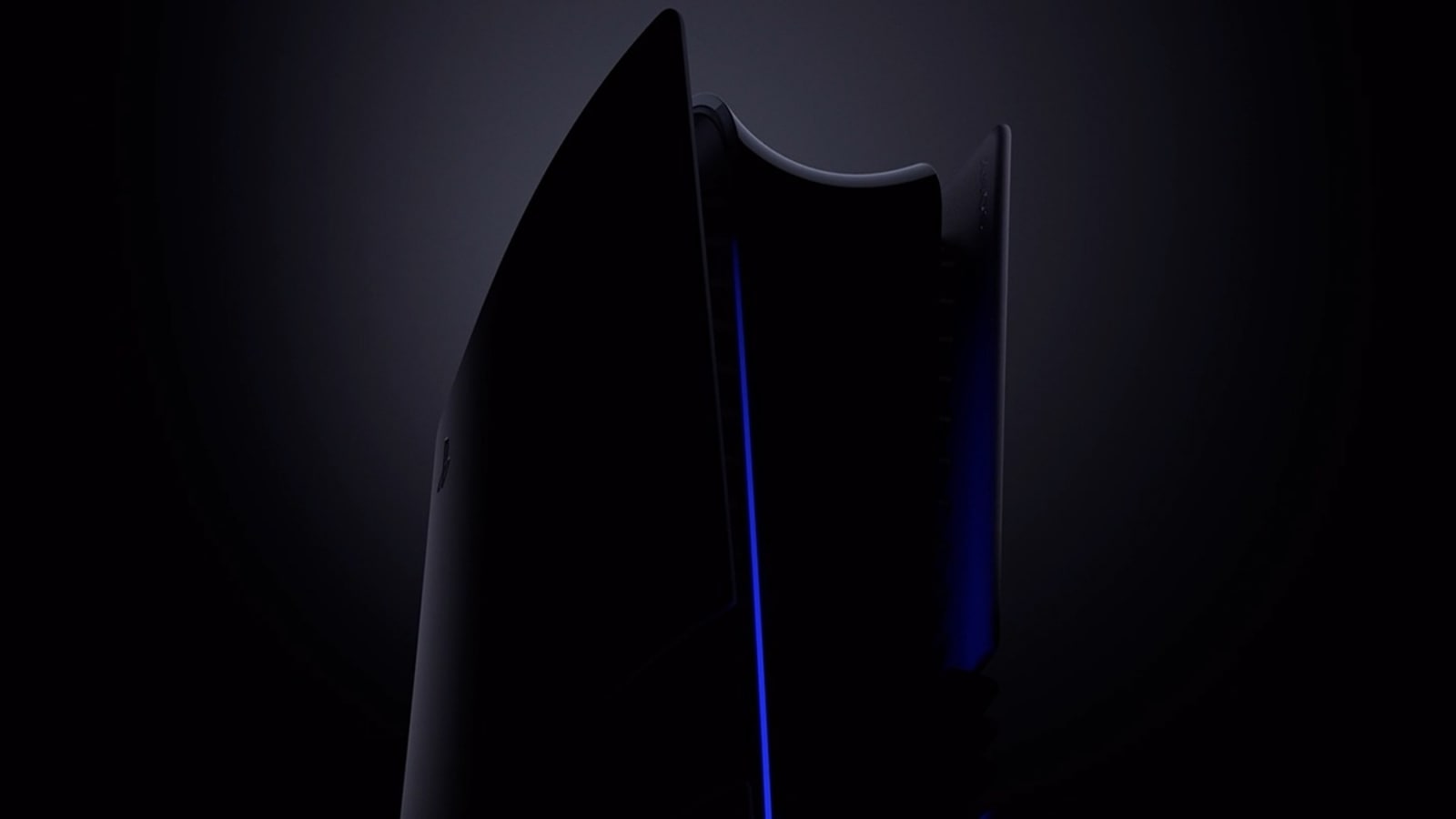Verdict
The Thrustmaster T818 Ferrari SF1000 Simulator racing wheel kit offers a powerful upgrade for anyone who has tried Thrustmaster’s great belt-driven models to date. However, the lack of console support is a shame and, if you’re not already a Thrustmaster fan, this may not be the first choice for those looking to try out direct drive wheel tech.
Pros
- Super-powerful and responsive force feedback
- Ridiculously comprehensive controls for certain uses
- Supports existing Thrustmaster wheels
Cons
- No console support (PC only)
- Expensive compared to some rivals
- Middling build quality in some parts
- Display represents a missed opportunity
Introduction
This is the big one. The Thrustmaster T818 is a direct-drive racing wheel from one of the biggest names in gaming peripherals. It’s the last to arrive from the three big names in tracing wheels too, after the brilliant Fanatec CSL DD and Logitech G Pro.
The Thrustmaster T818 Ferrari SF1000 Simulator kit aims to be a sort of “best of all worlds” kit. It includes a Thrustmaster TF1000 Ferrari replica wheel as well as the T818 wheelbase.
Is it a success? The Thrustmaster T818’s force feedback is excellent. It’s as strong as I think any remotely normal racing fan needs, it’s ultra-responsive and quiet.
However, this rig is also less polished than I’d expect from Thrustmaster in a few areas, frustrating in parts, and is going to appeal most to F1 fans who already have bought into the Thrustmaster ecosystem. It costs £999, and that does not include pedals. This makes it a match for the Logitech G Pro, and significantly more costly than some Fanatec CSL DD and Moza R9 kits.
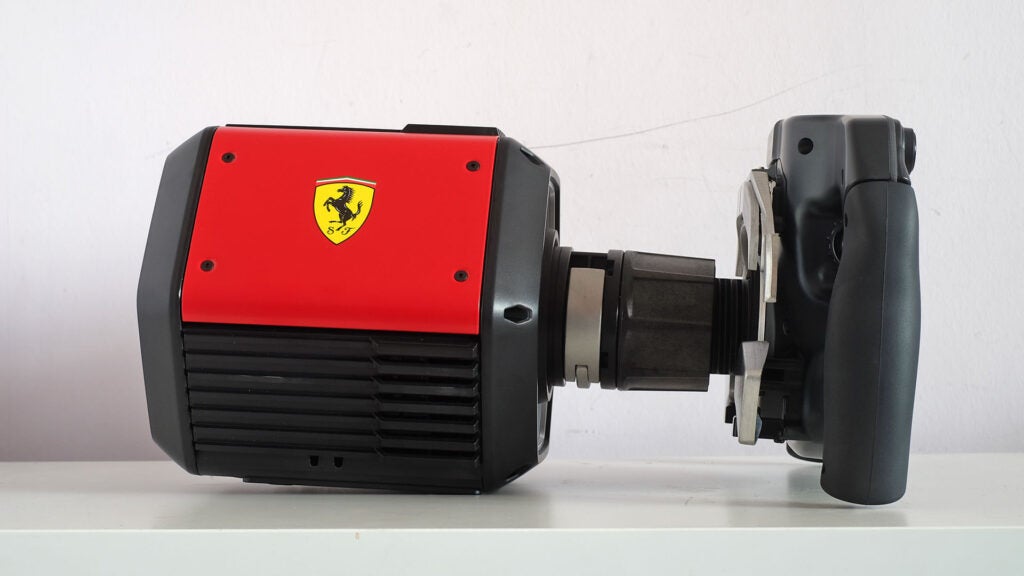
Design and Force Feedback
- Power 10Nm force feedback
- Direct drive transmission
- Supports existing Thrustmaster wheels
What’s so special about a direct-drive racing wheel like the Thrustmaster T818? It means the steering wheel is directly mounted onto the motor at the heart of the wheel. There are no intermediary layers of belts or gears, as found in all of the most popular affordable models.
With a geared system like the Logitech G920’s, you’re left with a sort of notched, granular feel to wheel rotation. That’s not ideal. Belt-driven force feedback can cause slippage, and generates a decent amount of heat, mandating the use of internal fans.
Some wheels like the Thrustmaster T248 use a mix of both styles. But with the direct drive, Thrustmaster T818 you avoid all these issues without spending a couple of grand this kind of technology demanded a few years back.
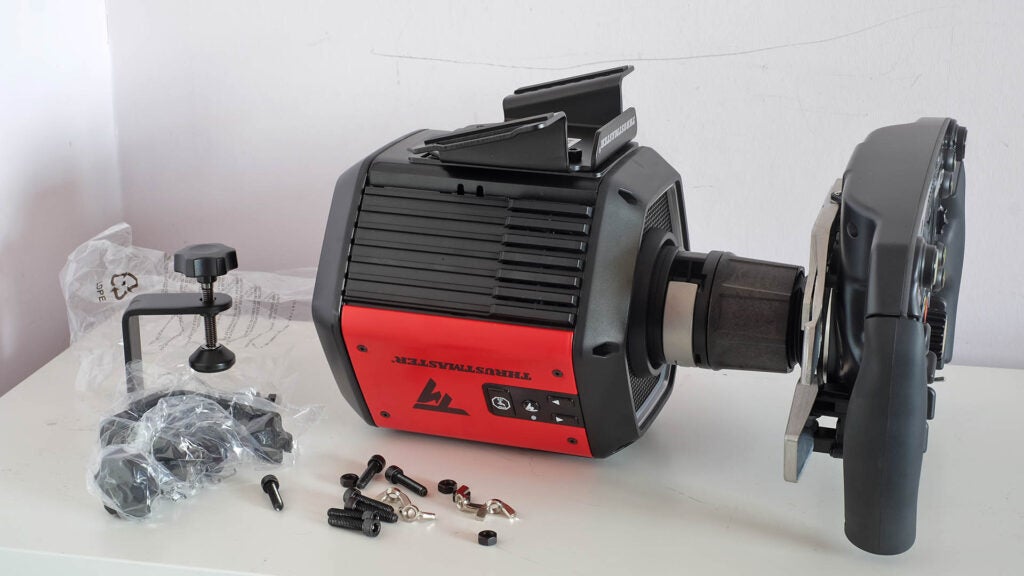
It’s terrific stuff, and the Thrustmaster T818 provides 10Nm of peak torque. Some of the truly specialist wheels from niche brands provide up to 25Nm, but I don’t really see the need for anything more than what you get here.
The Thrustmaster T818 can be punishingly rough. If I were looking to spend a long session, I’d consider dropping its intensity a touch. But for a few laps that peak power is just brilliantly immersive.
This is also greater torque than is offered by Fanatec in the CSL DD — 5Nm as standard, up to 8Nm with the boost kit, which is just a very expensive beefed-up power supply. I don’t find the Thrustmaster obviously more powerful or refined in person than the boosted CSL DD, though.

With either, you get serious power, excellent responsiveness and clarity of feedback. It also runs silent, with no need for an internal fan. You just miss out on the additional TruForce feedback of the Logitech G Pro. This is a gimmicky-sounding form of vibration haptics that works off, for example, the sound of the engine in a racing game. However, in use, it can add to the experience in an engaging fashion.
The Thrustmaster T818 is the least impressive of this new breed of direct drive wheel in its physical presence, though, even in this version decked out in Ferrari regalia. Its outer shell is plastic, making it seem much less hardwearing and substantial than the Fanatec CSL DD or Moza R9, which are corrugated bricks of aluminium.
Thrustmaster glosses things up a bit, using a customisable LED ring around the wheel base’s front. I’m not a fan of this nod to “gamer” PC hardware, and I’d bet the age of the average force feedback racing wheel user skews older, to begin with.
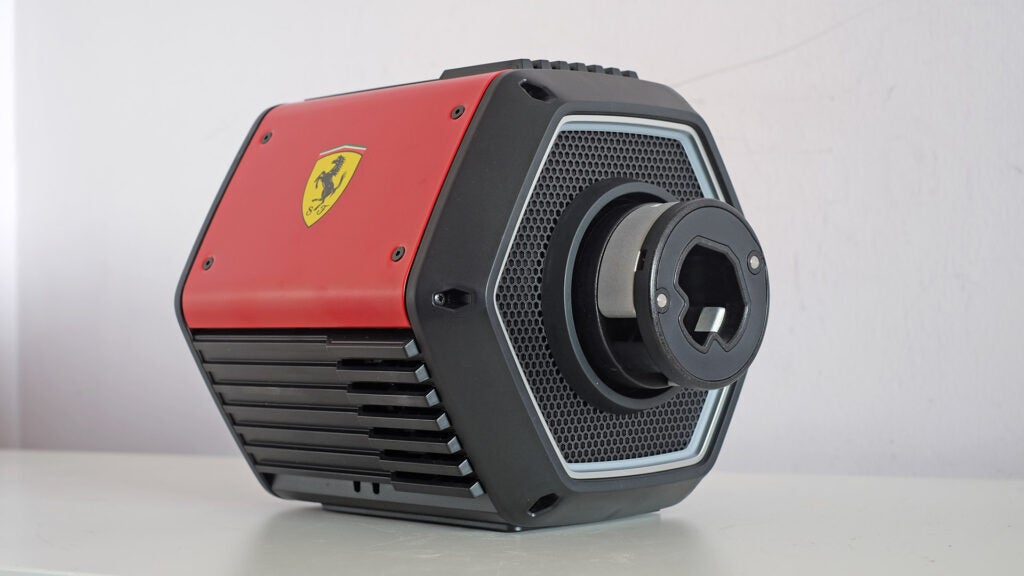
Features
- Tricky to fit onto existing stands and cockpits
- Uses a specific mount adapter
Still, perhaps aiming for the PC master race crowd isn’t the worst idea when that’s the only platform supported by this kit. Xbox and PS5 owners are left out. Logitech makes models of the G Pro wheel that support PC/Xbox and PC/PS. Fanatec’s DD Pro is for the PlayStation crowd, the standard DD for Xbox. Head to one of those if you want or need console support.
While I’m sure Thrustmaster will adapt this core hardware to work on consoles in a future model, I can’t see a future software update bringing this one up to par with the competition.
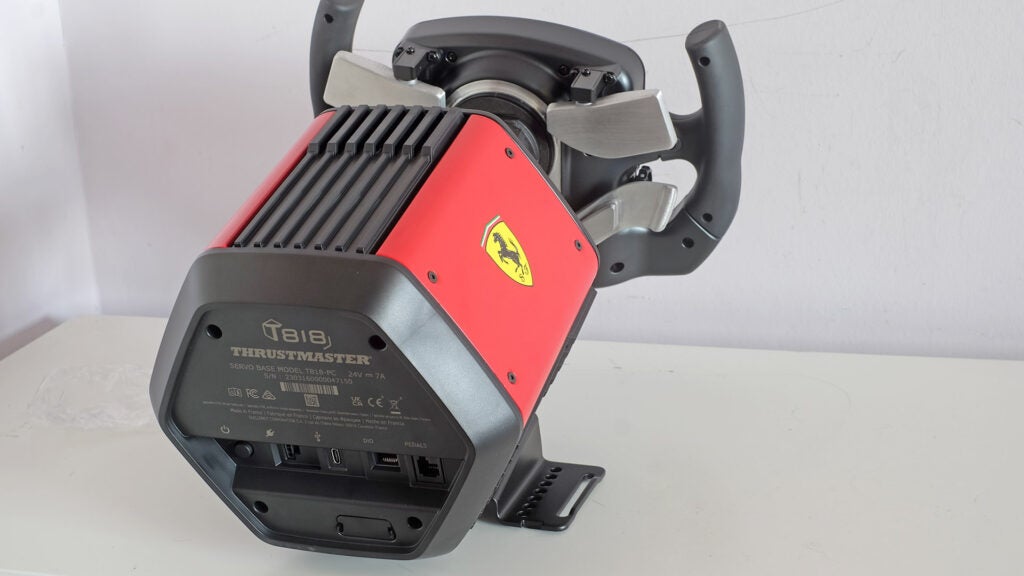
There are also some quirks to the Thrustmaster T818 that make it seem a bit of a mixed success. This base can use the same wheel rims as existing Thrustmaster models. That’s great. However, it requires a mount adapter I spent more than an hour trying to fit properly — the digital manual does admittedly explain the process much better than the crappy Quickstart guide found in the box of this kit.
The second issue is the mounting process. If you have an existing hard mounting rig, you’re likely to find it doesn’t have the right holes, reportedly cause by the small bottom surface area of the T818’s hexagonal wheelbase. I’m using Playseat Challenge, and have to either sort of cludge together a three-point mount technique that barely works, or use the classic two-point screw-in clamps. But these suit a more affordable racing wheel better than a high-end one like this. If you have a great cockpit already, you’d better get the drill out.
Wheel
- Huge number of on-wheel controls
- Plastic construction with a carbon fibre plate
- Neat inlaid display, but with limited game support
The particular kit I’m reviewing has a replica SF1000 Ferrari wheel. It looks mighty impressive, with its army of buttons and that racey shape, but it holds up better at arm’s length than in person.
This rim does suffer slightly from a complaint I levelled at the Thrustmaster T248, of focusing more on flashy surface-level tech than the core experience. There are a tonne of buttons here, but each is labelled with a naff sticker, some of which aren’t laid level. I’m not sure how well these will weather over time.
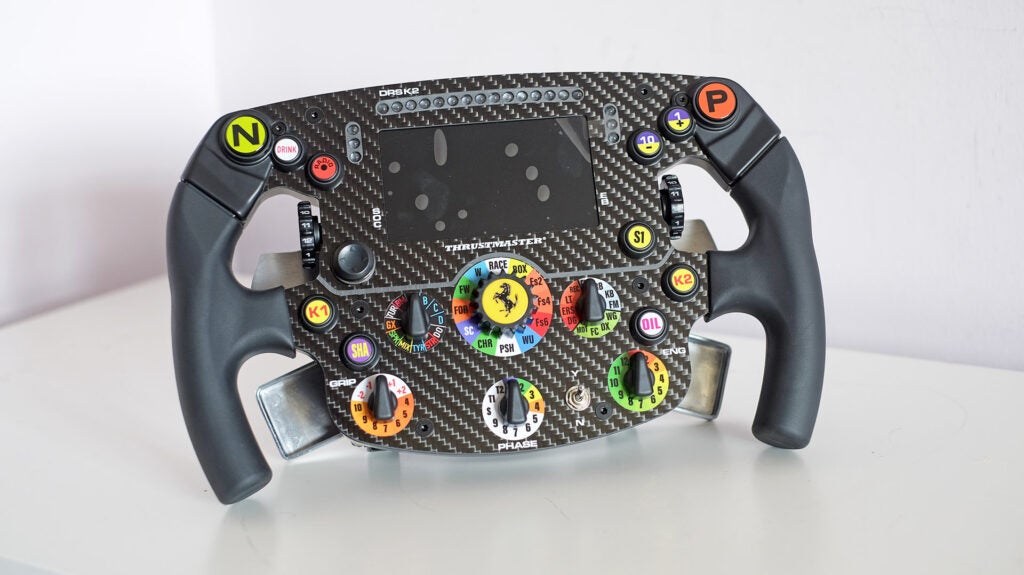
The underlying construction of the wheel is quite basic bar the flashy carbon fibre plate on its front. It’s a plastic core with rubber handles. This does the job just fine, of course, but a weightier metal wheel adds to the sense of realism and immersion, and it also affects the transmission of the force feedback a little.
Fanatec makes more impressively built steering wheels for comparable money. That’s the unbranded ones, anyway, as its BMW and Porsche wheels cost a fortune.
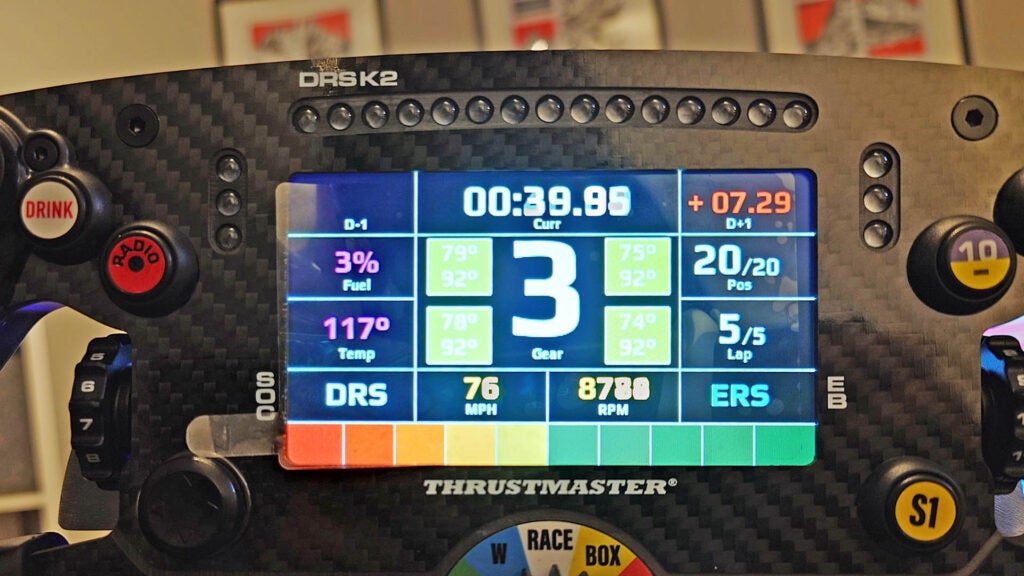
What they don’t have is the XL-size screen of Thrustmaster’s Ferrari wheel. This 4.3-inch display is used for telemetry data in select games. You can check out a list over at the Thrustmaster website, but unforunately it’s not a large list. At the time of review you’re basically looking at the F1 games from the last few years or Assetto Corsa Competizione. There are rev counter LEDs too but, again, they are only implemented in a limited number of games.
This screen doesn’t do a whole lot when not used alongside these games, repeating what is effectively a Ferrari screensaver. There’s no menu access, to control things like force feedback strength or maximum wheel rotation, and it seems a missed opportunity. Thrustmaster keeps things pretty simple on the customisation front in its PC application too, offering four “feel” based presets in the desktop app.
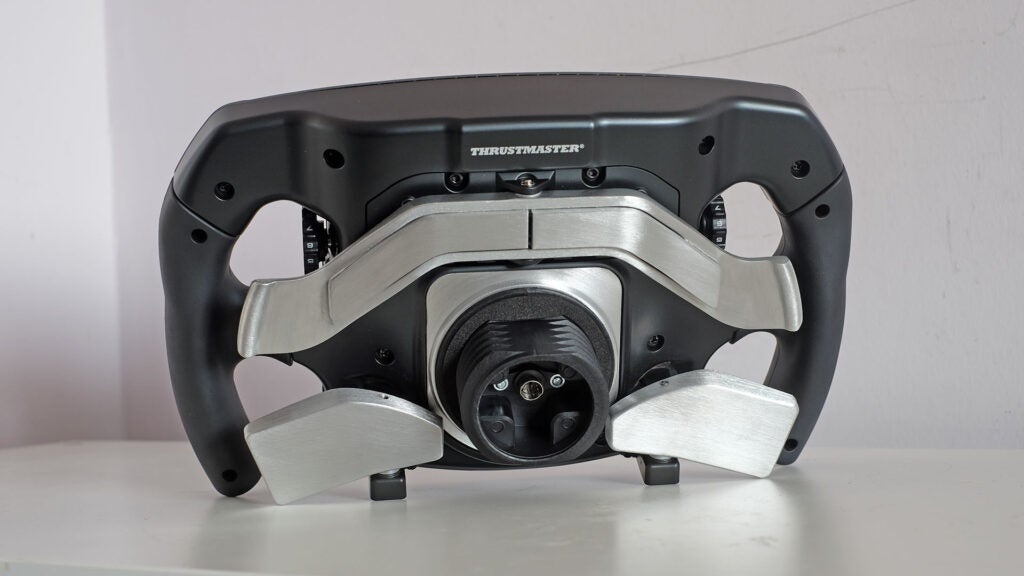
Unlike the steering wheel of the Thrustmaster T248, though, the SF1000’s shifters are good. This part is aluminium and provides a good positive click as you shift gears. The two controls are also joined in a see-saw-like fashion, as in the F1 car the steering wheel is based upon, apparently.
There are also lower clutch paddles, again mirroring those of the real-life F1 car. It’s all great stuff, but I just don’t find the presence of this wheel anywhere near as impressive as that of some other higher-end wheels I’ve used before that make use of materials like aluminium and Alcantara. Still, this SF1000 wheel is aimed at a niche audience of F1 fans of which I am not really a part, so take my complaints in that context.
Latest deals
Should you buy it?
You crave top-tier force feedback and user interaction
This kit provides the best force feedback I’ve felt in a Thrustmaster wheel to date. And while some might call it needless gloss, the 4.3-inch screen and dazzling array of controls are to impressive use in recent games from the F1 series.
No console support and plastic-ridden
This might be the toughest sell of the recent direct drive wheel sets. It doesn’t support any consoles, the largely plastic construction is less immediately impressive than that of its peers, including a couple of cheaper ones.
Final Thoughts
The Thrustmaster T818 Ferrari SF1000 Simulator is a world-class racing wheel package. It provides a straight-up fantastic racing experience. But is it the direct drive setup you should actually buy? That is more complicated.
Its steering wheel looks amazing, but the elements of the build are surprisingly basic. And only a tiny handful of games can make use of that telemetry screen. Mostly those from the F1 series.
The Logitech G Pro pips the Thrustmaster T818 Ferrari SF1000 Simulator for the overall force feedback feedback experience, and rivals with similar clout like the Fanatec CSL DD 8Nm and the Moza R9 provide similar power for less outlay. As such, I can largely recommend this wheel set to people already bought into the Thrustmaster ecosystem.
How we test
We use every gaming wheel we test for at least a week. During that time, we’ll check it for ease of use and put it through its paces by playing a variety of games.
We also check the controller’s software support, as well as the quality of bundled accessories such as pedals and shifters.
FAQs
It’s rated at 10Nm. This is a peak rather than a sustained rating, but it is still great power.
It is PC only, although the SF1000 wheel rim reviewed here does support bases with console support.
All current Thrustmatser sets work, but the T-LCM set is recommended at the time of review.
Verdict
The Thrustmaster T818 Ferrari SF1000 Simulator racing wheel kit offers a powerful upgrade for anyone who has tried Thrustmaster’s great belt-driven models to date. However, the lack of console support is a shame and, if you’re not already a Thrustmaster fan, this may not be the first choice for those looking to try out direct drive wheel tech.
Pros
- Super-powerful and responsive force feedback
- Ridiculously comprehensive controls for certain uses
- Supports existing Thrustmaster wheels
Cons
- No console support (PC only)
- Expensive compared to some rivals
- Middling build quality in some parts
- Display represents a missed opportunity
Introduction
This is the big one. The Thrustmaster T818 is a direct-drive racing wheel from one of the biggest names in gaming peripherals. It’s the last to arrive from the three big names in tracing wheels too, after the brilliant Fanatec CSL DD and Logitech G Pro.
The Thrustmaster T818 Ferrari SF1000 Simulator kit aims to be a sort of “best of all worlds” kit. It includes a Thrustmaster TF1000 Ferrari replica wheel as well as the T818 wheelbase.
Is it a success? The Thrustmaster T818’s force feedback is excellent. It’s as strong as I think any remotely normal racing fan needs, it’s ultra-responsive and quiet.
However, this rig is also less polished than I’d expect from Thrustmaster in a few areas, frustrating in parts, and is going to appeal most to F1 fans who already have bought into the Thrustmaster ecosystem. It costs £999, and that does not include pedals. This makes it a match for the Logitech G Pro, and significantly more costly than some Fanatec CSL DD and Moza R9 kits.

Design and Force Feedback
- Power 10Nm force feedback
- Direct drive transmission
- Supports existing Thrustmaster wheels
What’s so special about a direct-drive racing wheel like the Thrustmaster T818? It means the steering wheel is directly mounted onto the motor at the heart of the wheel. There are no intermediary layers of belts or gears, as found in all of the most popular affordable models.
With a geared system like the Logitech G920’s, you’re left with a sort of notched, granular feel to wheel rotation. That’s not ideal. Belt-driven force feedback can cause slippage, and generates a decent amount of heat, mandating the use of internal fans.
Some wheels like the Thrustmaster T248 use a mix of both styles. But with the direct drive, Thrustmaster T818 you avoid all these issues without spending a couple of grand this kind of technology demanded a few years back.

It’s terrific stuff, and the Thrustmaster T818 provides 10Nm of peak torque. Some of the truly specialist wheels from niche brands provide up to 25Nm, but I don’t really see the need for anything more than what you get here.
The Thrustmaster T818 can be punishingly rough. If I were looking to spend a long session, I’d consider dropping its intensity a touch. But for a few laps that peak power is just brilliantly immersive.
This is also greater torque than is offered by Fanatec in the CSL DD — 5Nm as standard, up to 8Nm with the boost kit, which is just a very expensive beefed-up power supply. I don’t find the Thrustmaster obviously more powerful or refined in person than the boosted CSL DD, though.

With either, you get serious power, excellent responsiveness and clarity of feedback. It also runs silent, with no need for an internal fan. You just miss out on the additional TruForce feedback of the Logitech G Pro. This is a gimmicky-sounding form of vibration haptics that works off, for example, the sound of the engine in a racing game. However, in use, it can add to the experience in an engaging fashion.
The Thrustmaster T818 is the least impressive of this new breed of direct drive wheel in its physical presence, though, even in this version decked out in Ferrari regalia. Its outer shell is plastic, making it seem much less hardwearing and substantial than the Fanatec CSL DD or Moza R9, which are corrugated bricks of aluminium.
Thrustmaster glosses things up a bit, using a customisable LED ring around the wheel base’s front. I’m not a fan of this nod to “gamer” PC hardware, and I’d bet the age of the average force feedback racing wheel user skews older, to begin with.

Features
- Tricky to fit onto existing stands and cockpits
- Uses a specific mount adapter
Still, perhaps aiming for the PC master race crowd isn’t the worst idea when that’s the only platform supported by this kit. Xbox and PS5 owners are left out. Logitech makes models of the G Pro wheel that support PC/Xbox and PC/PS. Fanatec’s DD Pro is for the PlayStation crowd, the standard DD for Xbox. Head to one of those if you want or need console support.
While I’m sure Thrustmaster will adapt this core hardware to work on consoles in a future model, I can’t see a future software update bringing this one up to par with the competition.

There are also some quirks to the Thrustmaster T818 that make it seem a bit of a mixed success. This base can use the same wheel rims as existing Thrustmaster models. That’s great. However, it requires a mount adapter I spent more than an hour trying to fit properly — the digital manual does admittedly explain the process much better than the crappy Quickstart guide found in the box of this kit.
The second issue is the mounting process. If you have an existing hard mounting rig, you’re likely to find it doesn’t have the right holes, reportedly cause by the small bottom surface area of the T818’s hexagonal wheelbase. I’m using Playseat Challenge, and have to either sort of cludge together a three-point mount technique that barely works, or use the classic two-point screw-in clamps. But these suit a more affordable racing wheel better than a high-end one like this. If you have a great cockpit already, you’d better get the drill out.
Wheel
- Huge number of on-wheel controls
- Plastic construction with a carbon fibre plate
- Neat inlaid display, but with limited game support
The particular kit I’m reviewing has a replica SF1000 Ferrari wheel. It looks mighty impressive, with its army of buttons and that racey shape, but it holds up better at arm’s length than in person.
This rim does suffer slightly from a complaint I levelled at the Thrustmaster T248, of focusing more on flashy surface-level tech than the core experience. There are a tonne of buttons here, but each is labelled with a naff sticker, some of which aren’t laid level. I’m not sure how well these will weather over time.

The underlying construction of the wheel is quite basic bar the flashy carbon fibre plate on its front. It’s a plastic core with rubber handles. This does the job just fine, of course, but a weightier metal wheel adds to the sense of realism and immersion, and it also affects the transmission of the force feedback a little.
Fanatec makes more impressively built steering wheels for comparable money. That’s the unbranded ones, anyway, as its BMW and Porsche wheels cost a fortune.

What they don’t have is the XL-size screen of Thrustmaster’s Ferrari wheel. This 4.3-inch display is used for telemetry data in select games. You can check out a list over at the Thrustmaster website, but unforunately it’s not a large list. At the time of review you’re basically looking at the F1 games from the last few years or Assetto Corsa Competizione. There are rev counter LEDs too but, again, they are only implemented in a limited number of games.
This screen doesn’t do a whole lot when not used alongside these games, repeating what is effectively a Ferrari screensaver. There’s no menu access, to control things like force feedback strength or maximum wheel rotation, and it seems a missed opportunity. Thrustmaster keeps things pretty simple on the customisation front in its PC application too, offering four “feel” based presets in the desktop app.

Unlike the steering wheel of the Thrustmaster T248, though, the SF1000’s shifters are good. This part is aluminium and provides a good positive click as you shift gears. The two controls are also joined in a see-saw-like fashion, as in the F1 car the steering wheel is based upon, apparently.
There are also lower clutch paddles, again mirroring those of the real-life F1 car. It’s all great stuff, but I just don’t find the presence of this wheel anywhere near as impressive as that of some other higher-end wheels I’ve used before that make use of materials like aluminium and Alcantara. Still, this SF1000 wheel is aimed at a niche audience of F1 fans of which I am not really a part, so take my complaints in that context.
Latest deals
Should you buy it?
You crave top-tier force feedback and user interaction
This kit provides the best force feedback I’ve felt in a Thrustmaster wheel to date. And while some might call it needless gloss, the 4.3-inch screen and dazzling array of controls are to impressive use in recent games from the F1 series.
No console support and plastic-ridden
This might be the toughest sell of the recent direct drive wheel sets. It doesn’t support any consoles, the largely plastic construction is less immediately impressive than that of its peers, including a couple of cheaper ones.
Final Thoughts
The Thrustmaster T818 Ferrari SF1000 Simulator is a world-class racing wheel package. It provides a straight-up fantastic racing experience. But is it the direct drive setup you should actually buy? That is more complicated.
Its steering wheel looks amazing, but the elements of the build are surprisingly basic. And only a tiny handful of games can make use of that telemetry screen. Mostly those from the F1 series.
The Logitech G Pro pips the Thrustmaster T818 Ferrari SF1000 Simulator for the overall force feedback feedback experience, and rivals with similar clout like the Fanatec CSL DD 8Nm and the Moza R9 provide similar power for less outlay. As such, I can largely recommend this wheel set to people already bought into the Thrustmaster ecosystem.
How we test
We use every gaming wheel we test for at least a week. During that time, we’ll check it for ease of use and put it through its paces by playing a variety of games.
We also check the controller’s software support, as well as the quality of bundled accessories such as pedals and shifters.
FAQs
It’s rated at 10Nm. This is a peak rather than a sustained rating, but it is still great power.
It is PC only, although the SF1000 wheel rim reviewed here does support bases with console support.
All current Thrustmatser sets work, but the T-LCM set is recommended at the time of review.








